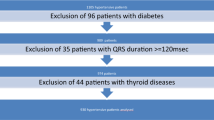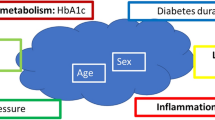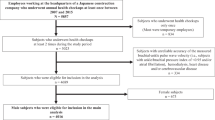Abstract
Dependence of the ambulatory arterial stiffness index (AASI) on data scattering interferes with its potential clinical relevance. We assessed the correlates and all-cause mortality associations of a modified AASI (s-AASI). AASI was derived from the 24-h diastolic vs systolic blood pressure linear regression line, whereas s-AASI was derived by symmetric regression (bisecting the line of diastolic vs systolic and systolic vs diastolic). Of 2918 patients 55% were women; age was 56±16 years and body mass index was 27.3±4.5 kg/m2. Average 24-h ambulatory blood pressure was 138±16/78±10 mm Hg. Applying the modified method for calculating AASI yielded a different measure: the negative correlation between AASI and blood pressure dipping (r=−0.304, P<0.0001) was abolished (r=+0.223, P<0.0001), s-AASI was more dependent on age (r=0.266 vs r=0.089 for AASI), and prediction of all-cause mortality was enhanced; hazard ratio (95% confidence intervals) 1.17 (1.00–1.36) per 1 s.d. increase in s-AASI in the fully adjusted model as compared with 1.15 (0.97–1.36) for AASI.
This is a preview of subscription content, access via your institution
Access options
Subscribe to this journal
Receive 12 digital issues and online access to articles
$119.00 per year
only $9.92 per issue
Buy this article
- Purchase on Springer Link
- Instant access to full article PDF
Prices may be subject to local taxes which are calculated during checkout


Similar content being viewed by others
References
Gosse P, Papaioanou G, Coulon P, Reuter S, Lemetayer P, Safar M . Can ambulatory blood-pressure monitoring provide reliable indices of arterial stiffness? Am J Hypertens 2007; 20: 831–838.
Gavish B, Ben Dov IZ, Bursztyn M . Linear relationship between systolic and diastolic blood pressure monitored over 24 h: assessment and correlates. J Hypertens 2008; 26: 199–209.
Li Y, Wang JG, Dolan E, Gao PJ, Guo HF, Nawrot T et al. Ambulatory arterial stiffness index derived from 24-h ambulatory blood pressure monitoring. Hypertension 2006; 47: 359–364.
Leoncini G, Ratto E, Viazzi F, Vaccaro V, Parodi A, Falqui V et al. Metabolic syndrome and ambulatory arterial stiffness index in non-diabetic patients with primary hypertension. J Hum Hypertens 2007; 21: 802–807.
Ratto E, Leoncini G, Viazzi F, Vaccaro V, Falqui V, Parodi A et al. Ambulatory arterial stiffness index and renal abnormalities in primary hypertension. J Hypertens 2006; 24: 2033–2038.
Leoncini G, Ratto E, Viazzi F, Vaccaro V, Parodi A, Falqui V et al. Increased ambulatory arterial stiffness index is associated with target organ damage in primary hypertension. Hypertension 2006; 48: 397–403.
Dolan E, Thijs L, Li Y, Atkins N, McCormack P, McClory S et al. Ambulatory arterial stiffness index as a predictor of cardiovascular mortality in the Dublin Outcome Study. Hypertension 2006; 47: 365–370.
Kikuya M, Staessen JA, Ohkubo T, Thijs L, Metoki H, Asayama K et al. Ambulatory arterial stiffness index and 24-h ambulatory pulse pressure as predictors of mortality in Ohasama, Japan. Stroke 2007; 38: 1161–1166.
Hansen TW, Staessen JA, Torp-Pedersen C, Rasmussen S, Li Y, Dolan E et al. Ambulatory arterial stiffness index predicts stroke in a general population. J Hypertens 2006; 24: 2247–2253.
Dechering DG, Adiyaman A, van der SM, Thien T . Interstudy variability in the ambulatory arterial stiffness index. Hypertension 2007; 50: e65.
Schillaci G, Parati G, Pirro M, Pucci G, Mannarino MR, Sperandini L et al. Ambulatory arterial stiffness index is not a specific marker of reduced arterial compliance. Hypertension 2007; 49: 986–991.
Gavish B . Correlating ambulatory blood pressure measurements with arterial stiffness: a conceptual inconsistency? Hypertension 2006; 48: e108.
Westerhof N, Lankhaar JW, Westerhof BE . Ambulatory arterial stiffness index is not a stiffness parameter but a ventriculo-arterial coupling factor. Hypertension 2007; 49: e7–e9.
Jerrard-Dunne P, Mahmud A, Feely J . Ambulatory arterial stiffness index, pulse wave velocity and augmentation index—interchangeable or mutually exclusive measures? J Hypertens 2008; 26: 529–534.
Palmas W, Pickering T, Eimicke JP, Moran A, Teresi J, Schwartz JE et al. Value of ambulatory arterial stiffness index and 24-h pulse pressure to predict progression of albuminuria in elderly people with diabetes mellitus. Am J Hypertens 2007; 20: 493–500.
Gavish B, Ben Dov IZ, Bursztyn M . Ambulatory arterial stiffness index is not a specific marker of reduced arterial compliance. Hypertension 2007; 50: e18.
Adiyaman A, Boggia J, Li Y, Wang JG, O'Brien E, Richart T et al. Dipping deeper into the ambulatory arterial stiffness index. Hypertension 2007; 50: e59–e60.
Schillaci G, Parati G, Pirro M, Pucci G, Mannarino MR, Sperandini L et al. Response to dipping deeper into the ambulatory arterial stiffness index. Hypertension 2007; 50: e61–e62.
Schillaci G, Pucci G, Pirro M, Parati G . Response to interstudy variability of ambulatory arterial stiffness index. Hypertension 2007; 50: e66.
Li Y, Wang JG, Dolan E, O'Brien E, Thijs L, Nawrot T et al. Response to correlating ambulatory blood pressure measurements with arterial stiffness: a conceptual inconsistency. Hypertension 2006; 48: e109.
Li Y, Wang JG, Dolan E, O'Brien E, Hansen TW, Ibsen H et al. Letter to the editor: response to arterial stiffness index is not a stiffness parameter but a ventriculo-arterial coupling factor. Hypertension 2007; 49: e8–e9.
Grin JM, McCabe EJ, White WB . Management of hypertension after ambulatory blood pressure monitoring. Ann Intern Med 1993; 118: 833–837.
Groppelli A, Omboni S, Parati G, Mancia G . Evaluation of noninvasive blood pressure monitoring devices Spacelabs 90202 and 90207 versus resting and ambulatory 24-h intra-arterial blood pressure. Hypertension 1992; 20: 227–232.
White WB, Lund-Johansen P, McCabe EJ, Omvik P . Clinical evaluation of the Accutracker II ambulatory blood pressure monitor: assessment of performance in two countries and comparison with sphygmomanometry and intra-arterial blood pressure at rest and during exercise. J Hypertens 1989; 7: 967–975.
White WB, Lund-Johansen P, Omvik P . Assessment of four ambulatory blood pressure monitors and measurements by clinicians versus intraarterial blood pressure at rest and during exercise. Am J Cardiol 1990; 65: 60–66.
Perk G, Mekler J, Bursztyn M . Ambulatory pulse pressure is a relatively sleep-independent variable. J Hypertens 2003; 21: 723–728.
Owens P, Atkins N, O'Brien E . Diagnosis of white coat hypertension by ambulatory blood pressure monitoring. Hypertension 1999; 34: 267–272.
von Eye A, Schuster C . Regression Analysis for Social Science, chapter 12, Academic Press: San Diego, 1998, pp 209–236.
Verdecchia P, Schillaci G, Reboldi G, Franklin SS, Porcellati C . Different prognostic impact of 24-h mean blood pressure and pulse pressure on stroke and coronary artery disease in essential hypertension. Circulation 2001; 103: 2579–2584.
Benetos A, Lacolley P . From 24-h blood pressure measurements to arterial stiffness: a valid short cut? Hypertension 2006; 47: 327–328.
Laurent S . Surrogate measures of arterial stiffness: do they have additive predictive value or are they only surrogates of a surrogate? Hypertension 2006; 47: 325–326.
O'Brien E . Ambulatory blood pressure measurement: a trove of hidden gems? Hypertension 2006; 48: 364–365.
Pickering TG, Shimbo D, Haas D . Ambulatory blood-pressure monitoring. N Engl J Med 2006; 354: 2368–2374.
O'Brien E, Sheridan J, O'Malley K . Dippers and non-dippers. Lancet 1988; 2: 397.
Imai Y, Abe K, Sasaki S, Minami N, Nihei M, Munakata M et al. Altered circadian blood pressure rhythm in patients with Cushing's syndrome. Hypertension 1988; 12: 11–19.
Kario K, Pickering TG, Umeda Y, Hoshide S, Hoshide Y, Morinari M et al. Morning surge in blood pressure as a predictor of silent and clinical cerebrovascular disease in elderly hypertensives: a prospective study. Circulation 2003; 107: 1401–1406.
Pickering TG, James GD, Boddie C, Harshfield GA, Blank S, Laragh JH . How common is white coat hypertension? JAMA 1988; 259: 225–228.
Verdecchia P, Schillaci G, Borgioni C, Ciucci A, Telera MP, Pede S et al. Adverse prognostic value of a blunted circadian rhythm of heart rate in essential hypertension. J Hypertens 1998; 16: 1335–1343.
Ben Dov IZ, Kark JD, Ben Ishay D, Mekler J, Ben Arie L, Bursztyn M . Blunted heart rate dip during sleep and all-cause mortality. Arch Intern Med 2007; 167: 2116–2121.
Acknowledgements
Itay Almog provided invaluable assistance in handling old data files. Part of this work was presented at the AHA-CHBPR 2007 meeting.
Author information
Authors and Affiliations
Corresponding author
Rights and permissions
About this article
Cite this article
Ben-Dov, I., Gavish, B., Kark, J. et al. A modified ambulatory arterial stiffness index is independently associated with all-cause mortality. J Hum Hypertens 22, 761–766 (2008). https://doi.org/10.1038/jhh.2008.50
Received:
Revised:
Accepted:
Published:
Issue Date:
DOI: https://doi.org/10.1038/jhh.2008.50
Keywords
This article is cited by
-
Treatment-induced changes in ambulatory arterial stiffness index: one-year prospective study and meta-analysis of evidence
Hypertension Research (2015)
-
The relationship between systolic and diastolic blood pressure: a clinically meaningful slope?
Hypertension Research (2011)
-
Ambulatory Arterial Stiffness Index: Reproducibility of Different Definitions
American Journal of Hypertension (2010)
-
More Information on the Reproducibility of the Ambulatory Arterial Stiffness Index
American Journal of Hypertension (2010)
-
The dynamic relationship between systolic and diastolic blood pressure: yet another marker of vascular aging?
Hypertension Research (2010)



